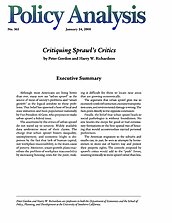Although most Americans are living better than ever, many now see “urban sprawl” as the source of most of society’s problems and “smart growth” as the logical antidote to those problems. That belief has spawned a host of local and state initiatives and been popularized nationally by Vice President Al Gore, who proposes to make urban sprawl a federal issue.
The assertions by the critics of urban sprawl do not stand up to scrutiny. Widely available data undermine most of their claims. The charge that urban sprawl fosters inequality, unemployment, and economic blight is disproven by the fact that lack of human capital, not workplace inaccessibility, is the main cause of poverty. Moreover, smart-growth plans exacerbate the problem of workplace inaccessibility by increasing housing costs for the poor, making it difficult for them to locate near areas that are growing economically.
The argument that urban sprawl gives rise to excessively costly infrastructure, excessive transportation costs, and environmental damage is wrong. The facts point directly to the opposite conclusion.
Finally, the belief that urban sprawl leads to social pathologies is without foundation. No one knows the recipe for good or bad community formations or the best spatial mix of housing that would accommodate myriad personal preferences.
The American migration to the suburbs and exurbs can, in part, be seen as attempts by homeowners to move out of harm’s way and protect their property rights. The controls proposed by sprawl’s critics would add to the “push” forces, resulting ironically in more sprawl rather than less.
About the Authors

This work is licensed under a Creative Commons Attribution-NonCommercial-ShareAlike 4.0 International License.
